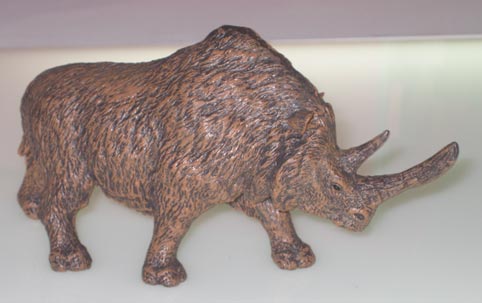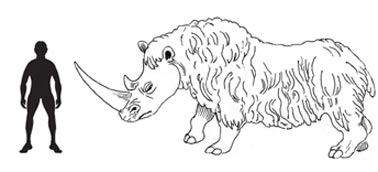Woolly Rhino – An Odd Shaped Rhino Horn
Woolly Rhino (Coelodonta antiquitatis) – Odd Shaped Horns
Whilst one of our team members was doing some dinosaur themed teaching activities with school children before the half-term holiday, they were asked by a student why did Woolly Rhinos had such large horns?
A Replica of a Woolly Rhino

Great care has been taken to depict the anterior horn on the new Papo model. Picture credit: Everything Dinosaur.
Picture credit: Everything Dinosaur
The picture (above) shows the Papo Woolly Rhino model, to view the Papo range of prehistoric animal models and figures: Papo Prehistoric Animal Models.
The question was asked when the Mammoth tooth was being handed round and it did get us thinking as to why ancient Rhinos had large horns. In truth, we had to do a little bit of research before we could provide a complete explanation. We were able to send an email to the teacher, outlining some of the reasons for the large horn on the Woolly Rhino.
Woolly Rhino
It turns out that the particular pupil concerned had seen a model of a Woolly Rhino and it did have a very large nose horn when she compared it to her models of modern Rhinos in her zoo play set. Rhinocerotidae (the family to which Rhinoceroses belong), is actually quite an ancient mammal group, with their fossil record dating back to the Oligocene, approximately 35 million years ago. There were a number of Rhino species around during the Ice Ages of the Pleistocene Epoch, fossils of such animals have been found all over Asia and Europe, these ancient animals were much more widespread in the past than modern species. It is believed that the first Woolly Rhinos originated in China and there were a number of different types or species.
Coelodonta antiquitatis was named and described in 1807 by the German anthropologist and naturalist Johann Friedrich Blumenbach, long before the term Dinosauria had been thought of. Indeed, Regency museums had many exhibitions of prehistoric mammal fossils long before dinosaur fossils began to take centre stage.
An Illustration of a Woolly Rhinoceros

Picture credit: Everything Dinosaur
To see a model of a Woolly Rhino and other prehistoric mammals associated with the Ice Age and the Pleistocene Epoch: Dinosaur and Prehistoric Animal Models.
Coelodonta antiquitatis
Coelodonta antiquitatis had two horns on its snout, the front horn being larger than the second horn located between the eyes. Woolly Rhinos were stocky, covered in long, shaggy hair with short legs, small ears and a dumpy tail – all adaptations for living in cold climates. The horns of rhinos are made of keratin (fibrous hair that it compressed), the front horn (known as the anterior horn), could grow up to about 2 metres in length. It is believed that the males had larger horns than females.
Scientists believe that the front horn of the Woolly Rhino was keeled, it was constantly worn down as the animals grazed moving their heads from side to side. Woolly Rhinos may have used their large horns to clear snow in order to find food, this may explain how these animals had peculiar shaped horns. Animals with large horns may have been more successful engaging in ritual combat and winning more mates as well as finding food. The genetic trait for large horns may then have been passed from generation to generation. This might explain why over many generations Woolly Rhinos had larger horns.

